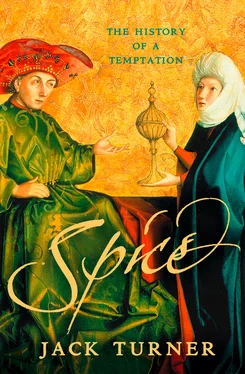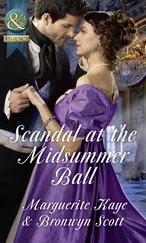For between harvest and consumption Europe’s spices travelled a long and fragile thread. The spice routes mazed across the map like the wanderings of a black ant, criss-crossing seas and deserts, now appearing then abruptly vanishing and reappearing, forking and branching with the rise and fall of cities and empires, outbreaks of war and fluctuating demand. When the visiting King and Queen of Scotland celebrated the Feast of the Assumption at Woodstock in 1256 with no less than fifty pounds each of ginger, pepper and cinnamon, four pounds of cloves, two pounds each of nutmeg and mace and two pounds of galangal, * their seasonings had travelled journeys the diners could barely guess at, acquiring an air of glamour and otherworldiness that we can only with difficulty imagine.
No spices were more travelled or more exotic than the cloves, nutmeg and mace of the Moluccas. Served to the visiting monarchs in a glass of spiced wine, all that can be known with any degree of certainty is their origin. After harvest in the nutmeg groves of the Bandas or in the shadow of the volcanic cones of Ternate and Tidore, next, most likely, they were stowed on one of the outriggers that still flit between the islands of the archipelago. Alternatively, they may have been acquired by Chinese traders known to have visited the Moluccas from the thirteenth century onwards. Moving west past Sulawesi, Borneo and Java, through the straits of Malacca, they were shipped to India and the spice-marts of Malabar. Next, Arab dhows conveyed them across the Indian Ocean to the Persian Gulf or the Red Sea. At any one of a number of ancient ports – Basra, Jiddah, Muscat or Aqaba – the spices were transferred onto one of the huge caravans that fanned out across the deserts to the markets of Arabia and on to Alexandria and the Levant.
Only in Mediterranean waters did the spices come at last into European hands. By the turn of the millennium they crop up in the records of cities spread around its shores: Marseilles, Barcelona, Ragusa. Some spices arrived via Byzantium and the Black Sea, following the Danube to eastern and central Europe, but the greatest volume of traffic passed through Alexandria and the Levant to Italy. From Italy a number of routes led north over the Alpine passes towards France and Germany. Alternatively, which was both safer and faster, Venetian or Genoese galleys freighted spices out of the Mediterranean, through the straits of Gibraltar and up and around the Iberian peninsula before docking in view of the gothic spire of St Paul’s. From a Thameside wharf they were transferred into the store of a London merchant – as likely to have been Italian, Flemish or German as English – then in and out of a royal spicer’s cupboard before finally ending their long journey in the royal stomach.
If such was the system, however faintly we discern it, contemporaries saw it more faintly still – a fact that did not stifle, but rather stimulated, the imagination. It was a romance-writer’s stock-in-trade that spices perfume the air of the more beautiful dreamworlds that are such a feature of medieval literature. In a Castilian version of The Romance of Alexander written around the middle of the thirteenth century, galangal, cinnamon, ginger, cloves and zedoary * waft through the air of the dreamscape. Much like Coleridge transported to the sunny ice-caves of Xanadu, the anonymous author of Mum and the Sothsegger left behind the greyness and grinding poverty of the fourteenth-century English countryside for a vision of a blissful, better land, where the Golden Age endured in all its spicy abundance and lushness. The fantasyland of the Romance of the Rose, among the most widely read and emulated poems of the age, is similarly rose-tinted and spice-scented. In evoking these fairer climes spices were as much a poetic convention as pearly teeth and snowy breasts, chivalrous knights and damsels in distress.
While poets and mystics were generally content to perfume the air of their paradise with spices, and to leave it at that, others made more concerted efforts to map the fabulous locales where the spices grew. This was, necessarily, a highly creative enterprise. Since all reports of paradise and spices alike arrived second-hand, the medieval imagination was free to run riot. Though nothing could be confirmed (or, more to the point, disproved), what was generally agreed was that spices came from a topsy-turvy world where the normal rules of European life did not apply. They were securely lodged in the same world as the marvels and misshapen prodigies that writhe across the portals of Europe’s Romanesque churches or scamper and cavort across its manuscripts. An illumination in a fourteenth-century manuscript in the Bibliothèque Nationale has a team of swarthy Indians in loincloths harvesting pepper in wicker baskets while a European merchant samples the crop; so far at least the botanical details are not far removed from the reality. Nearby, however, a gaggle of dog-headed Indians haggles over the harvest, men with faces set in their chests gambol among the bushes and others hop around on a single, stout foot.
In its mix of half-accurate detail and wild distortion this was a fairly representative example of European visions of the East. But how seriously were such depictions meant to be taken? There is a risk, in considering these and similar visions, that our own modern credulity outstrips the medieval. Evidently, some of the more fabulous tales of the Indies and their spices were never intended to be taken literally; they are a notoriously unreliable guide to informed opinion, and a trap for the unwary. In the fantastic Asia of such illuminations we are, manifestly, in a not-Europe. But while the tone of such depictions is often playful or didactic, what is clear is that they derived their force from their very invertedness. And spices were, for their creators, a means to that end. It is precisely through this fictive inversion that we, however dimly, can sense how extraordinary spices were in fact. Like the dog-headed men and man-devouring amazons with which they were paired, spices were as ordinary in the imagined Indies as they were exceptional in Europe; that they were commonplace in medieval fantasies was because they were extraordinary in reality.
Retrospectively, of course, it is a little easier to extract the fact from the fantasy, but in medieval times the lines were more blurred. It is precisely this sense of a world turned upside-down and inside-out that animates the genre of more-or-less fictional travellers’ tales that appears from roughly the thirteenth century on. Many such were parodies, such as that of Brother Cipolla of The Decameron, with his trip to Liarland (‘where I found a great many friars’) and Parsnip, India, with its amazing flying feathers. Of these the most celebrated, and in every sense the spiciest, was the Itinerarium conventionally attributed to one Sir John Mandeville, a suitably chivalric-sounding pseudonym of an anonymous, probably French, author. First circulated in various versions and translations between 1356 and 1366, along with the other by-now stock features of the marvellous Eastern landscape – Gog and Magog, Prester John, the Great Khan and his Asian Utopia – spices are one of the hallmarks of his fantastic tableaux. Ginger, cloves, cinnamon, nutmeg and mace grew in Java ‘more plentyfoulisch than in any other contree’, a land that had ‘many tymes overcomen the Grete Cane of Cathaye in bataylle’. Here, perhaps, is a grain of fact, a vague awareness of Javanese traders shuttling spices west from the Moluccas; so much the author might have learned from Marco Polo. But the force, and the point – for Mandeville (or whoever) wrote not to inform, but to amaze – is of the extraordinary become prosaic. Read on and there are ox-worshipping Cynocephales, corpse-eating savages and gems engendered from the tears of Adam and Eve. Such was the world where the spices grew. Along with the dragons and the mountains of gold, they were one of its distinguishing features.
Читать дальше











